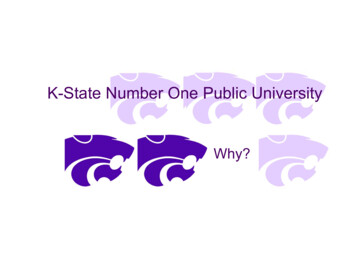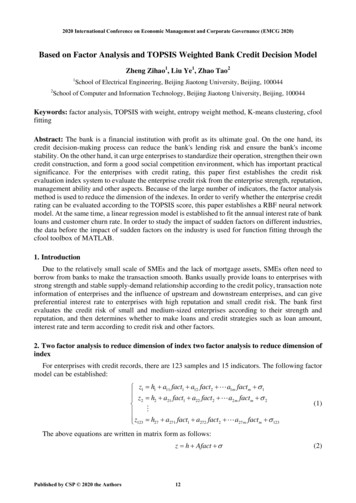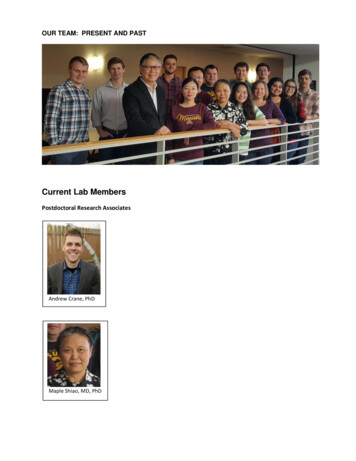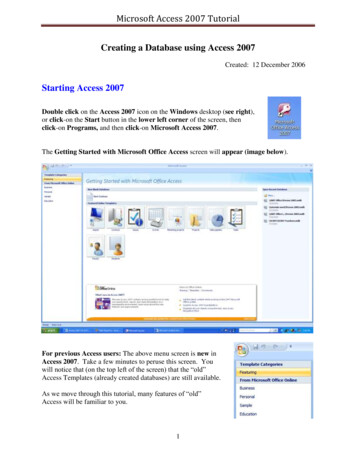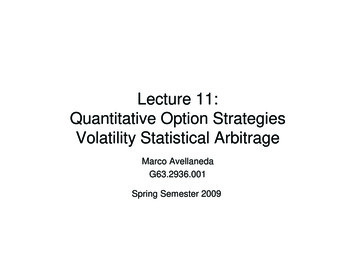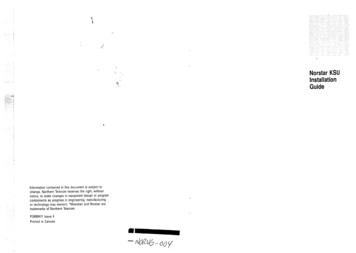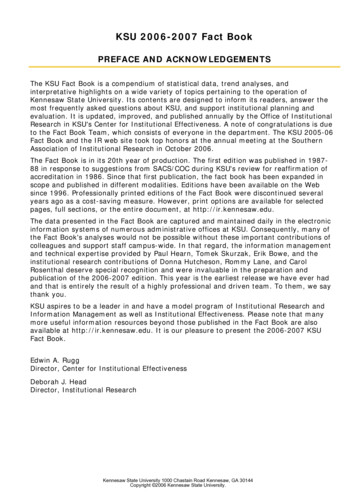
Transcription
KSU 2006-2007 Fact BookPREFACE AND ACKNOWLEDGEMENTSThe KSU Fact Book is a compendium of statistical data, trend analyses, andinterpretative highlights on a wide variety of topics pertaining to the operation ofKennesaw State University. Its contents are designed to inform its readers, answer themost frequently asked questions about KSU, and support institutional planning andevaluation. It is updated, improved, and published annually by the Office of InstitutionalResearch in KSU's Center for Institutional Effectiveness. A note of congratulations is dueto the Fact Book Team, which consists of everyone in the department. The KSU 2005-06Fact Book and the IR web site took top honors at the annual meeting at the SouthernAssociation of Institutional Research in October 2006.The Fact Book is in its 20th year of production. The first edition was published in 198788 in response to suggestions from SACS/COC during KSU's review for reaffirmation ofaccreditation in 1986. Since that first publication, the fact book has been expanded inscope and published in different modalities. Editions have been available on the Websince 1996. Professionally printed editions of the Fact Book were discontinued severalyears ago as a cost-saving measure. However, print options are available for selectedpages, full sections, or the entire document, at http://ir.kennesaw.edu.The data presented in the Fact Book are captured and maintained daily in the electronicinformation systems of numerous administrative offices at KSU. Consequently, many ofthe Fact Book's analyses would not be possible without these important contributions ofcolleagues and support staff campus-wide. In that regard, the information managementand technical expertise provided by Paul Hearn, Tomek Skurzak, Erik Bowe, and theinstitutional research contributions of Donna Hutcheson, Rommy Lane, and CarolRosenthal deserve special recognition and were invaluable in the preparation andpublication of the 2006-2007 edition. This year is the earliest release we have ever hadand that is entirely the result of a highly professional and driven team. To them, we saythank you.KSU aspires to be a leader in and have a model program of Institutional Research andInformation Management as well as Institutional Effectiveness. Please note that manymore useful information resources beyond those published in the Fact Book are alsoavailable at http://ir.kennesaw.edu. It is our pleasure to present the 2006-2007 KSUFact Book.Edwin A. RuggDirector, Center for Institutional EffectivenessDeborah J. HeadDirector, Institutional ResearchKennesaw State University 1000 Chastain Road Kennesaw, GA 30144Copyright 2006 Kennesaw State University.
KSU 2006-2007 Fact BookGeneral Information Highlights: 2002 - Present Highlights: 1996 - 2001 Highlights: 1990 - 1995 Highlights: 1980 - 1989 Highlights: 1963 - 1979 Institutional Mission Accreditation University Administration Academic Affairs Division - Provost's Council of Deans Business & Administration Division Student Success & Enrollment Services Division Information Technology Division University College School of the Arts Coles College of Business Bagwell College of Education Wellstar College of Health and Human Services College of Humanities & Social Sciences College of Science & Mathematics Continuing Education University Advancement DivisionKennesaw State University 1000 Chastain Road Kennesaw, GA 30144Copyright 2006 Kennesaw State University.Page 2 of 153
KSU 2006-2007 Fact BookHighlights: 2002 - PresentFebruary 16, 2006: Dr. Daniel S. Papp was named as president of KSU.May 12, 2005: Dr. Betty L. Siegel, KSU's second president and one of the longestserving female presidents in the nation, announced she will be stepping down after 25years of leadership.The new KSU Dance Company will perform at the American College Dance Conferencein 2006.In April 2005, the KSU cheerleading team won their second consecutive NCA NationalChampionship.2004 - 2005 KSU's Athletic Department moves from Division II to Division I and joinsthe Atlantic Sun Conference.Addition of the North Parking Deck in 2004 brought 1,558 new parking spaces primarily used by the residents of KSU's University Village.In March 2004, the men's basketball team won the NCAA Division II NationalChampionship.In 2004, the KSU cheerleading team took home their first national championship afterthree consecutive national runner-up finishes from 2001-2003.In 2003, the women's soccer team captured the NCAA Division II NationalChampionship.The Bagwell College of Education recieved the 2003 Best Practice Award for theInnovative Use of Technology from the American Association of Colleges of TeacherEducation.KSU celebrated its 40th anniversary in 2003.Women's soccer was a highlight for the athletic department at KSU. In the Fall of 2002a new soccer field was completed and a team was recruited for the new season. Theteam finished with a successful first season.The Clendenin Building, housing the Computer Science and Information Systemsdepartment, opened during the Summer of 2002. This added 11 high-tech classroomsand 35 more faculty offices with a total of over 37,000 square feet.Fall 2002 was the first semester the two new parking decks, the West Deck and theEast Deck, were opened to relieve some of the parking issues experienced by studentsduring peak enrollment times.Another major space addition in Fall 2002 included nine homes that existed on FreyLake Road that were purchased by the KSU Foundation and converted to office spacefor a number of centers such as the International Center, Institutional Effectiveness,CETL, Health, and CAREing.Kennesaw State University 1000 Chastain Road Kennesaw, GA 30144Copyright 2006 Kennesaw State University.Page 3 of 153
An historical event for KSU was the building and acquisition of residential apartmentsfor students beginning Fall 2002. University Place was built on existing land andoffered 700 beds while KSU Place was purchased and provided another 400 beds forstudents. The popularity of the living-learning centers was demonstrated by filling theapartments to capacity within the first semester of opening. The KSU Foundationsponsored the building and leasing of the properties.KSU passed an enrollment milestone during Fall 2002, when the number of studentsexceeded 15,500 and the number of new beginning freshmen reached an all-time highof over 2000.Kennesaw State University 1000 Chastain Road Kennesaw, GA 30144Copyright 2006 Kennesaw State University.Page 4 of 153
KSU 2006-2007 Fact BookHighlights: 1996 - 2001Two new degree programs were approved under the Bachelor of Science degree. TheGeographic Information Science major was implemented in Spring 2001 and theCriminal Justice major was approved in Spring 2002.A new masters of science degree in Applied Computer Science for ExperiencedProfessionals debuted in Fall 2001.The Visual Arts building, which offers over 35,000 square feet of classroom and officespace, opened in Spring of 2001.The beautiful campus green, circled by the Millennium Walk was dedicated in April2000.KSU was approved to begin offering in the fall of 2000 a new masters program inConflict Management which is housed in the College of Humanities and SocialSciences, under the Department of Political Science.In 1999, KSU leased the Kinder Outlet Mall through the KSU Foundation andrenovated it to house the Continuing Education Division giving them the much neededclassroom and conference facilities for their programs. There are a few other campusfunctions housed in the newly named Kennesaw State University Center, such as theBurruss Center, the campus Mail Room and the University Foundation Offices.The student center addition opened in the summer of 1999, tripling the amount ofpresent space available for student success and development opportunities.In 1998-99, KSU added a School of the Arts as a home to the departments of Music,Theatre, and Visual Arts. Additionally, the School of Nursing was changed to theCollege of Health and Human Services bringing together related departments ofNursing, Primary Care Nursing, Public Administration, and Health and PhysicalEducation. The College of Humanities and Social Sciences included a new departmentof Sociology, Geography, and Anthropology.The first graduate program in the College of Science and Mathematics opened inspring semester 1999 with a Master of Science in Information Systems, enrolling 20students.The rerouting of Frey Road was completed in 1998 enabling thirty additional acres tobe joined with the rest of the campus. On this property, the new Kennesaw Hall, whichhouses the Bagwell College of Education, Student Success, and central administrativeoffices, opened in the summer of 1999.Several new building projects were under construction in 1998. The renovation of theNatural Science Building to the Nursing Building was completed in the summer of1998. The Legacy Gazebo, built with funds raised by the KSU Staff Council, opened in1997 and the accompanying Teahouse opened in 1998.Fall 1998 was the first term of the newly implemented semester system.In 1997, KSU awarded its first honorary doctorate to lifelong trustee, Clarice C.Bagwell.Kennesaw State University 1000 Chastain Road Kennesaw, GA 30144Copyright 2006 Kennesaw State University.Page 5 of 153
The College of Education was named after benefactors Clarice and Leland Bagwell,longtime educators and long-standing Kennesaw State friends. The University receivedthe largest gift in its history, 680 acres of land in Bartow County on behalf of theBagwells.The Bagwell College of Education accepted its first class in the newly approved Masterof Education in Special Education Interrelated for the fall of 1997.The Coles College of Business was listed in the 1996 Success Magazine report on "The25 Best Business Schools for Entrepreneurship" as one of the "Top 10 Up-and-Comers".The baseball and softball teams won the NCAA Division II national championships in1996. KSU became only the second Division I or II team in NCAA history to win bothtitles in the same season.In April 1996, the KSU School of Nursing was reaccredited by the National League ofNursing with outstanding remarks and no recommendations.Kennesaw State achieved high marks from the team of Southern Association ofColleges and Schools reviewers and was fully reaccredited at undergraduate andgraduate levels in 1996.Kennesaw State College became Kennesaw State University on June 12, 1996, whenthe Board of Regents approved a reorganization plan and granted university status tomany of the senior colleges in the state. Part of the reorganization allowed KSU torename four of the five schools to colleges.Kennesaw State University 1000 Chastain Road Kennesaw, GA 30144Copyright 2006 Kennesaw State University.Page 6 of 153
KSU 2006-2007 Fact BookHighlights: 1990 - 1995A 15 million building to house the College of Science and Mathematics opened inJanuary of 1996.The Master of Science in Nursing for primary care nurse practitioners accepted its firstclass in the Winter, 1996.Another innovative masters program was approved by the Board of Regents. TheMaster of Arts in Professional Writing admitted its first class fall quarter 1995.The Michael J. Coles School of Business was granted full accreditation by the AmericanAssembly of Collegiate Schools of Business in 1994. At the same time, KSC completeda highly successful accreditation visit by the National Council for the Accreditation ofTeacher Education (NCATE) meeting all 18 standards and gained accreditation at theadvanced and basic levels.In July, 1994, the School of Nursing was approved by the Board of Regents, becomingthe fifth school of the college. The School of Science and Allied Health was renamed tothe School of Science and Mathematics.The School of Business Administration was named after entrepreneur andphilanthropist, Michael J. Coles in 1994 who donated in excess of 1 million to the KSCFoundation. Additionally, a second endowed chair in the business school wasestablished the Tony and Jack Dinos Chair of Entrepreneurial Management.The Educational Technology Center, established in 1993, houses a 2 million state-ofthe-art laboratory with a distance learning classroom for pre-service and in-serviceteacher training for instructional improvement.The Lex and LeoDelle Jolley Lodge, made possible through the KSC Foundation and amajor gift by the Jolleys, was officially opened in the fall of 1993. It provides morethan 6,000 square feet of space on campus to be used for retreats, meetings andsocial gatherings.Additionally, in 1993, 30 acres across Frey Road were acquired by the college andhave been used for future campus expansion including a multipurpose building andadditional parking.In an effort to creatively expand space for the college, a 50,000-square foot officecomplex at Chastain Center, located near the campus, was leased. The Division ofContinuing Education, the School of Nursing and the Small Business DevelopmentCenter moved to that location.The Master of Accounting degree officially enrolled its initial class of graduate studentsduring the fall of 1993.A new Department of Public Administration and Human Services was formed in 1992and initiated a Master of Public Administration program in the fall of 1993 with 45graduate students.An 18-month Master of Business Administration for Experienced Professionals programwas initiated with the first 51 graduate students in January, 1993.Kennesaw State University 1000 Chastain Road Kennesaw, GA 30144Copyright 2006 Kennesaw State University.Page 7 of 153
Evidence of solid student outcomes continued to emerge in the 1980s and 1990s. Inthe last decade, more than 90% of the nursing graduates passed the licensing examon the first attempt. KSC teacher education graduates led the state in passing rate onthe Teacher Certification Exam.The 100,000-square foot A.L. Burruss Building, home for the School of BusinessAdministration, opened in 1991, setting the precedent for other large academicbuildings to be planned for KSC.After five years of careful study and preparation, a new general education (core)program was fully implemented in 1991.In 1990, the Department of Curriculum and Instruction was divided into thedepartments of Elementary and Early Childhood Education and Secondary and MiddleSchool Education. A new Department of Communication was also created.A campus chapter of Phi Kappa Phi National Honor Society was installed during the1990-91 year.In 1990, the admissions office added a new system called Telephone AdmissionsStatus Inquiry (TASI) that offers students 24-hour, seven-days-a-week access toadmissions information, including the status of their application, admissions deadlines,test-score requirements and other valuable information.The fall 1990 enrollment surpassed 10,000 students for the first time in the history ofthe college.From 1986 to 1990, as a result of raised admission standards and more stringentexiting requirements, developmental studies enrollment decreased 28% while the USGdevelopmental enrollment grew by 60%.Kennesaw State University 1000 Chastain Road Kennesaw, GA 30144Copyright 2006 Kennesaw State University.Page 8 of 153
KSU 2006-2007 Fact BookHighlights: 1980 - 1989In the fall of 1989, KSC was one of only five institutions in the South named by U.S.News and World Report as one of the "Top Up-And-Coming Regional Colleges andUniversities" of the nation. In 1990, U.S. News and World Report again spotlightedKennesaw State, along with George Mason University, as among the "best up andcoming colleges" in the South. KSC was again singled out as a "rising star" in 1991.In the fall of 1990, a campus-wide policy prohibiting smoking in any building wasimplemented to promote the healthiest possible environment for the faculty, staff andstudents.Telephone registration was successfully implemented during the Spring Quarter 1990.In the spring of 1990, the library was named in honor of Horace W. Sturgis, thefounding president.The School of Business Administration established the first degree program inprofessional sales in the nation in 1990.The college added a performing arts auditorium to its physical resources in 1989.The fall of 1988 saw the opening of the A.L. Burruss Institute of Public Service, whichwas the first major public service/applied research center in the college.Critical demands for space led to the construction of four temporary classroom/facultyoffice buildings in 1988 and 1989.The initial Master of Business Administration graduates earned perfect grade pointaverages (4.0). The Center for Excellence in Teaching and Learning and its newsletter,Reaching Through Teaching, focused faculty attention on the excitement of teaching atKennesaw State.Throughout the 1980s, the centrality of effective teaching grew in importance atKennesaw State. Graduates of the KSC education programs continued to lead allothers in the state with a 98% passing rate on the Teacher Certification Test. All(100%) students in the initial graduating class in the Bachelor of Science in Nursingprogram passed their licensing exams.In 1988, Kennesaw College requested a change in name to Kennesaw State College.The change was approved by the Board of Regents and took effect during the 25thyear anniversary of the college.In keeping with its continuing development as a four-year college with graduateprograms, in 1988 the faculty approved a plan to discontinue all associate degreesexcept the program in nursing.The Kennesaw College Foundation initiated its first capital campaign in 1987-88 withan initial goal of 4 million in cooperation with the Foundation for Southern Tech.Kennesaw was selected to be spotlighted in Searching for Academic Excellence (1986)as one of 20 colleges and universities in the nation "on the move."In 1986, Kennesaw became one of the first institutions in our region to bereaccredited by the Southern Association of Colleges and Schools under its newcriteria, which emphasized institutional effectiveness.The first graduate programs (in business and education) were initiated in 1985.Kennesaw State University 1000 Chastain Road Kennesaw, GA 30144Copyright 2006 Kennesaw State University.Page 9 of 153
In 1983, the organizational structure within academic affairs changed from fivedivisions to four schools and 17 departments better reflecting the four-year status.Major advances in minority faculty, staff and student involvement at Kennesaw wereachieved in the 1980s.Intercollegiate Athletics was originated in 1982.In 1981, Dr. Betty L. Siegel became the first female president in the UniversitySystem of Georgia when she succeeded Dr. Sturgis, the founding president atKennesaw, and acting president Dr. Eugene Huck.Buildings added since 1967 include a new student center in 1973, a new library in1979, a new plant operations building in 1973 and three new academic buildings(Humanities in 1979, Continuing Education/Performing Arts in 1989 and BusinessAdministration in 1991). The original student center later became the AdministrationAnnex, the original library became the W. Wyman Pilcher Public Service Building, theformer plant operations facility became the Music Building, and the initial HumanitiesBuilding became Business Administration and later became the Education Building.Kennesaw State University 1000 Chastain Road Kennesaw, GA 30144Copyright 2006 Kennesaw State University.Page 10 of 153
KSU 2006-2007 Fact BookHighlights: 1963 - 1979Before the college even opened in 1966, community leaders and local residentswanted to know when it would become a four-year institution. Thanks to the strongcommitment of community leaders, local government officials, students, faculty andstaff, Kennesaw Junior College was granted senior college status in 1976 and renamedKennesaw College in September 1977. The junior year was added in the fall of 1978,and the senior year in 1979. In June of 1980, 70 students received the firstbaccalaureate degrees to be conferred by the college. Later that year, the collegebecame fully accredited as a four-year institution by the Southern Association ofColleges and Schools (SACS).The Kennesaw Junior College Foundation was created during the 1968-69 academicyear, with 23 charter members made up of respected, influential businessmen fromCobb and surrounding counties.The matriculation fee in 1966-67 was 70 per quarter for full-time students and 6per credit hour for part-time students. The day the college opened, there were only 37faculty members on board. According to the annual Presidential Reports publishedduring those first few years, one-third of the student body attended night classes, andmen outnumbered women by a ratio of 2:1.The construction costs of the eight initial buildings totalled 4 million, roughly 87% ofwhich came from Cobb County, the City of Marietta and a federal grant.The initial campus also sported a physical education building, social science buildingand a maintenance building, which opened in 1967, bringing the total to eightbuildings.By January 9, 1967, the campus was ready for occupancy, although most of thebuildings were still in the final stages of construction. The science, humanities andstudent services buildings were the first to open. The administration building openedwithin a month, but the library was not ready until April. Bookshelves were set up inthe physics lab as a temporary library from January through April. (The library heldonly 4,200 volumes when it opened.)The college opened its doors in September of 1966 with a student body of 1,014, butthe campus was not ready for occupancy, so temporary quarters were set up that fallat Southern Technical Institute (where most classes were held), the Marietta HousingAuthority at Marietta Place (which provided office space for the administrators) andthe Banberry Elementary School. The office of the President was located in theSouthern Tech administration building. By the summer of 1966, the administrativestaff, along with data processing, was at Banberry. The first registration occured atMarietta Place in the Recreation Building. Developmental Studies was also held atMarietta Place.Dr. Horace W. Sturgis took office as president of the college on July 1, 1965, and theinstitution was officially named Kennesaw Junior College in August of that year.The Georgia Board of Regents approved the creation of a new institution, tentativelynamed Cobb County Junior College, on October 9, 1963. The original stationery waslabeled "Marietta College" and the Marietta Journal sometimes used the name"Kennesaw Mountain Junior College." The program for the ground breaking ceremonyof November 18, 1964, was simply headed "Cobb County University of GeorgiaSystem College."Kennesaw State University 1000 Chastain Road Kennesaw, GA 30144Copyright 2006 Kennesaw State University.Page 11 of 153
KSU 2006-2007 Fact BookInstitutional MissionKennesaw State University is a proud public university in the University System ofGeorgia, located in the densely populated and rapidly developing northwest region ofGreater Metropolitan Atlanta. Chartered in 1963, KSU serves as a highly valuedresource for educational, economic, social and cultural advancement.This institution shares with all other units in the University System of Georgia thefollowing characteristics: a supportive campus climate, necessary services and leadership developmentopportunities, all to educate the whole person and meet the needs of students,faculty and staff;cultural, ethnic, racial and gender diversity in the faculty, staff and studentbody, supported by practices and programs that embody the ideals of an open,democratic and global society;technology to advance educational purposes, including instructional technology,student support services and distance education;collaborative relationships with other System institutions, State agencies, localschools and technical institutes, and business and industry, sharing physical,human, information and other resources to expand and enhance programs andservices available to the citizens of Georgia.This institution shares with all other state universities in the University System ofGeorgia the following characteristics: a commitment to excellence and responsiveness within a scope of influencedefined by the needs of an area of the state, and by particularly outstandingprograms or distinctive characteristics that have a magnet effect throughout theregion or state;a commitment to teaching/learning environment, both inside and outside theclassroom, that sustains instructional excellence, serves a diverse anduniversity-prepared student body, promotes high levels of student achievement,offers academic assistance and provides developmental studies programs for alimited student cohort;a high quality general education program supporting a variety of disciplinary,interdisciplinary and professional academic programming at the baccalaureatelevel with selected masters and educational specialist degrees and selectedassociate degree programs based on area need and/or interinstitutionalcollaborations;a commitment to public service, continuing education, technical assistance, andeconomic development activities that address the needs, improve the quality oflife and raise the educational level within the scope of influence;Kennesaw State University 1000 Chastain Road Kennesaw, GA 30144Copyright 2006 Kennesaw State University.Page 12 of 153
a commitment to scholarly and creative work to enhance instructionaleffectiveness and to encourage faculty scholarly pursuits and a commitment toapplied research in selected areas of institutional strength and area need.Distinctive characteristics of Kennesaw State University are described as follows:Kennesaw State serves a diverse student body in the northern suburbs of Atlanta andextending into northwest Georgia. It includes young adults who enroll as freshmen orundergraduate transfers and an equally large number of older adults who return ortransfer to the university at different stages in their lives for undergraduate orgraduate study. A majority pursue their academic goals on a part-time basis becauseof job, family and civic responsibilities. Significant numbers of international andminority students enroll. Many students pursue professionally-oriented degrees,especially at the graduate level. Evening and weekend programs accommodateexperienced professionals seeking academic advancement. A broad range of programs,services and activities are offered outside the classroom to enrich campus life andenhance student success and personal development.Effective teaching and learning are central institutional priorities. Service and researchthat strengthen teaching and address the public interests are important supportivepriorities. Faculty, staff and administrators are committed to providing a challengingand facilitative collegiate environment that fosters high-quality academic preparation,critical thinking, global and multicultural perspectives, effective communication andinterpersonal skills, leadership development, social responsibility and lifelong learning.Programs that prepare students well for the advancement of professional pursuits areespecially attractive and are offered in all schools of the university.The foundation for all undergraduate majors is a comprehensive and coherent generaleducation program that promotes internationalized and connected learning in theliberal arts tradition. A wide array of baccalaureate degree programs is offered,including majors in the arts, humanities, social sciences, mathematics, naturalsciences, accounting, business fields, teacher education, computing and informationsystems and nursing. An expanding array of professional master degrees exists ineducation, accounting, business fields, public administration, professional writing andnursing.A commitment to public service is reflected through an extensive array of continuingeducation programs, service institutes and centers, nationally recognized lecturers andconferences, collaboratives with the public schools, partnerships with business andgovernmental agencies and international initiatives. The university plays a vital role inpromoting and supporting regional interests in the visual, performing and cultural arts.Research, scholarship and creative activity are broadly defined and predominantlyapplied. The university honors action research on the improvement of teaching andlearning; survey research for community and economic development; interdisciplinarystudies in support of environmental, governmental, business, or health interests;creative contributions in the arts and humanities; intellectual contributions; discoveryresearch and academic publication; and the interpretation or application of academicresearch.Kennesaw State University aspires to be a progressive and exemplary educationalinstitution, respected for its excellence and leadership in its teaching, service andresearch. The university is committed to continuous improvement in an increasinglydiverse and constantly changing learning community.Kennesaw State University 1000 Chastain Road Kennesaw, GA 30144Copyright 2006 Kennesaw State University.Page 13 of 153
KSU 2006-2007 Fact BookAccreditationKennesaw State University is accredited by the Commission on Colleges of theSouthern Association of Colleges and Schools to award bachelor's, master's, specialistand doctoral degrees. Inquiries related to the university?s accreditation by theCommission may be directed to COC/SACS, 1866 Southern Lane, Decatur, Georgia30033-4097, telephone 404-679-4500, Web site: www.sacscoc.org. Questions relatedto admissions and the policies, programs, and practices of KSU should be directed tothe university?s offices, catalogs, publications, or Web sites.College of the ArtsMusicThe undergraduate music program is accredited by the National Association of Schoolsof Music.TheatreThe und
Nursing with outstanding remarks and no recommendations. Kennesaw State achieved high marks from the team of Southern Association of Colleges and Schools reviewers and was fully reaccredited at undergraduate and graduate levels in 1996. Kennesaw State College became Kennesaw State University on June 12, 1996, when


